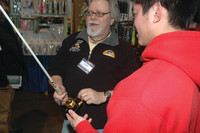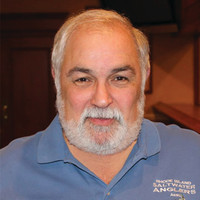The Magnuson-Stevens Act (MSA), the nation’s landmark fisheries law, is now 40 years old. I attended a senate hearing last week in Washington, DC to review the MSA.
Members of the …
This item is available in full to subscribers.
We have recently launched a new and improved website. To continue reading, you will need to either log into your subscriber account, or purchase a new subscription.
If you are a current print subscriber, you can set up a free website account by clicking here.
Otherwise, click here to view your options for subscribing.
Please log in to continue |
|


The Magnuson-Stevens Act (MSA), the nation’s landmark fisheries law, is now 40 years old. I attended a senate hearing last week in Washington, DC to review the MSA.
Members of the oceans subcommittee of the Senate Commerce, Science and Transportation Committee asked questions and heard testimony on the successes, challenges and forward path of the law that had been reauthorized in 1996 and 2006.
Samuel D. Rauch III, Deputy Assistant Administrator for Regulatory Programs at the National Oceanic and Atmospheric Administration (NOAA), offered testimony.
The bipartisan support of the MSA was very uplifting. Many Senators noted the MSA has been very successful rebuilding fish stocks and is a global model for sustainable fisheries.
Some Senators related fisheries shortcomings that exist under the MSA such as the ability to handle challenges in fish populations due to climate change and warming water, the devastation of the ground fishery in the Gulf of Maine, the need to be more responsive to fishermen and fishing communities.
Senator Markey of Massachusetts brought up the plight of fishermen in his state that are catching large numbers of summer flounder and black sea bass and having to throw thousands of pounds of dead fish overboard because quotes have been kept too low without taking climate change into consideration. Scientists believe climate change has caused a shift in the bio mass of these species up the east coast due to warming water in New England. Senator Markey asked, “How is NOAA taking these climate changes into account when establishing fishing quotas.”
Samuel Rauch of NOAA addressed the climate change issue by relating work NOAA scientists have done in this area, as well as relating how many of the other issues raised by senators were being addressed or could be addressed within the existing MSA law.
Matt Tinning, senior director, U.S. Oceans Programs for the Environmental Defense Fund attended the hearing and said, “In some fisheries, improvements in management must be considered. But needed changes can be advanced within the existing legal framework (of the MSA), including through the stakeholder-driven regional council process that the MSA created. A complicated and protracted process of opening up the Magnuson-Stevens Act for reauthorization at this time is not only unnecessary but would be counter-productive. We urge Congress to keep what’s working.”
Congress is exploring new legislation to revise or reauthorize the MSA. Many in the fishing community believe it is fine the way it is and that improvements can be made within the existing law. Others believe that reauthorized or not, MSA needs safeguards added to address key issues such as eco-system based management.
How to land spring striped bass
“Fishing for Spring Striped Bass” was the topic at Monday night’s panel discussion at the West Valley Inn, West Warwick. Striped bass experts Capt. Randy Bagwell of River Rebel Charters, Capt. Eric Thomas of Teezer 77 Guide Service and local striper surfcasting expert Dennis Zambrotta conducted the panel discussion on how to land striped bass from shore and boat at the Rhode Island Saltwater Angler Association meeting.
Five seminar takeaways included:
First, you have to make it happen. Be prepared to do a number of different things to catch spring striped bass as every day is different. What works one day may not work the next day. Be prepared to live line menhaden, fish with chucked menhaden, soft plastics, troll with umbrella rigs, etc. What appeals to the fish today may be far from what they want tomorrow.
Second, most spring bass are in skinny water… two to five feet close to shore when casting lures and up to 25 feet when fishing with live bait, fresh chunked bait or when trolling.
Third, fish early morning or at night. Night brings darkness and poor visibility so bass feed aggressively as they believe they are safe from predators. Dawn provides still water so you can actually see the bait and fish movement on the surface.
And fourth, fish where there is a lot of water movement – ledges as well as channel edges or channel pads where fish may be staging to ambush bait. Fish like points where the land narrows and water rushes through pushing and tossing bait around – such as the channel pads of the shipping channel from Sandy Point Prudence Island to downtown Providence.
Where’s the bite
Not much fishing occurred last week as weather continued to keep boats in port. When they got out, the fishing was only fair. Party boats sailing for cod fish at this time include the Frances Fleet at www.francesfleet.com, the Seven B’s at www.sevenbs.com and the Island Current at www.islandcurrent.com.
Captain Dave Monti has been fishing and shell fishing for over 40 years. He holds a captain’s master license and a charter fishing license. Visit Captain Dave’s No Fluke website at www.noflukefishing.com or e-mail him with your fishing news and photos at dmontifish@verizon.net.
Comments
No comments on this item Please log in to comment by clicking here